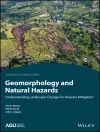Filling a niche in the geomorphology teaching market, this
introductory book is built around a 12 week course in fluvial
geomorphology.
‘Reading the landscape’ entails making sense
of what a riverscape looks like, how it works, how it has evolved
over time, and how alterations to one part of a catchment may have
secondary consequences elsewhere, over different timeframes. These
place-based field analyses are framed within their topographic,
climatic and environmental context. Issues and principles presented
in the first part of this book provide foundational understandings
that underpin the approach to reading the landscape that is
presented in the second half of the book. In reading the landscape,
detective-style investigations and interpretations are tied to
theoretical and conceptual principles to generate
catchment-specific analyses of river character, behaviour and
evolution, including responses to human disturbance.
This book has been constructed as an introductory text on river
landscapes, providing a bridge and/or companion to
quantitatively-framed or modelled approaches to landscape analysis
that are addressed elsewhere. Key principles outlined in the book
emphasise the importance of complexity, contingency and emergence
in interpreting the character, behaviour and evolution of any given
system.
The target audience is second and third year undergraduate
students in geomorphology, hydrology, earth science and
environmental science, as well as river practitioners who use
geomorphic understandings to guide scientific and/or management
applications.
The primary focus of Kirstie and Gary’s research and
teaching entails the use of geomorphic principles as a tool with
which to develop coherent scientific understandings of river
systems, and the application of these understandings in management
practice. Kirstie and Gary are co-developers of the River
Styles® Framework and Short Course that is widely used in
river management, decision-making and training.
Additional resources for this book can be found at: href=’http://www.wiley.com/go/fryirs/riversystems’>www.wiley.com/go/fryirs/riversystems.
introductory book is built around a 12 week course in fluvial
geomorphology.
‘Reading the landscape’ entails making sense
of what a riverscape looks like, how it works, how it has evolved
over time, and how alterations to one part of a catchment may have
secondary consequences elsewhere, over different timeframes. These
place-based field analyses are framed within their topographic,
climatic and environmental context. Issues and principles presented
in the first part of this book provide foundational understandings
that underpin the approach to reading the landscape that is
presented in the second half of the book. In reading the landscape,
detective-style investigations and interpretations are tied to
theoretical and conceptual principles to generate
catchment-specific analyses of river character, behaviour and
evolution, including responses to human disturbance.
This book has been constructed as an introductory text on river
landscapes, providing a bridge and/or companion to
quantitatively-framed or modelled approaches to landscape analysis
that are addressed elsewhere. Key principles outlined in the book
emphasise the importance of complexity, contingency and emergence
in interpreting the character, behaviour and evolution of any given
system.
The target audience is second and third year undergraduate
students in geomorphology, hydrology, earth science and
environmental science, as well as river practitioners who use
geomorphic understandings to guide scientific and/or management
applications.
The primary focus of Kirstie and Gary’s research and
teaching entails the use of geomorphic principles as a tool with
which to develop coherent scientific understandings of river
systems, and the application of these understandings in management
practice. Kirstie and Gary are co-developers of the River
Styles® Framework and Short Course that is widely used in
river management, decision-making and training.
Additional resources for this book can be found at: href=’http://www.wiley.com/go/fryirs/riversystems’>www.wiley.com/go/fryirs/riversystems.
Daftar Isi
Chapter 1 introduces the reader to key conceptual tools with which to analyse rivers. We will examine what fluvial geomorphology is, and introduce the notion of reading the landscape..Chapter 2 considers process relationships at the catchment-scale, emphasizing patterns and linkages within drainage basins and along longitudinal profiles..
Chapter 3 examines the fundamental energy conditions that fashion the geomorphology of rivers, emphasizing how these relationships vary at different positions in catchments..
Chapters 4-7 build up a picture of the primary components of river systems, starting at the finer scale and working through to a synthesis on river diversity in Chapter 8. Chapter 4 examines processes on the bed of rivers, focusing upon sediment transport and bed material organization. Chapter 5 analyses the erosional and depositional landforms that make up river channels. Chapter 6 integrates processes on the bed and banks of rivers to analyse variation in channel geometry. Chapter 7 considers the range of forms and processes that create and rework floodplains. The synthesis presented in chapter 8 reviews the spectrum of river character and behaviour..
Chapter 9 analyses forms and scales of river adjustment. River behaviour is differentiated from river change. River evolution is framed in context of geological and climatic controls..
Chapter 10 appraises river responses to human disturbance..
Management implications are examined in Chapter 11.
Tentang Penulis
Kirstie Fryirs is a Senior Lecturer in the Department ofEnvironment and Geography at Macquarie University in Sydney,
Australia. She has worked extensively on river systems in
Australia. Her research focuses on geomorphic river
evolution, post-European disturbance responses, sediment budgets
and connectivity, and geoecology. Her research is used extensively
in river management practice.
Gary Brierley is Chair of Physical Geography in the
School of Environment at the University of Auckland, New Zealand.
Building upon his geomorphic research on river systems in western
Canada, Australia and New Zealand, his recent work has been
undertaken in western China and parts of South America. His
research interests also include concerns for environmental justice,
transitional practices in river science and management, and
emerging approaches to environmental governance.
Beli ebook ini dan dapatkan 1 lagi GRATIS!
Bahasa Inggris ● Format PDF ● Halaman 362 ● ISBN 9781118305423 ● Ukuran file 42.3 MB ● Penerbit John Wiley & Sons ● Diterbitkan 2012 ● Edisi 1 ● Diunduh 24 bulan ● Mata uang EUR ● ID 2591107 ● Perlindungan salinan Adobe DRM
Membutuhkan pembaca ebook yang mampu DRM












